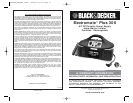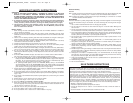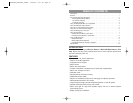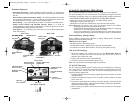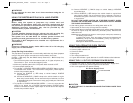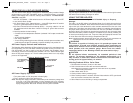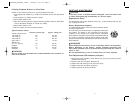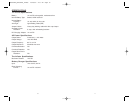
IMPORT
ANT SAFETY INSTRUCTIONS
WARNINGS
1. RISK OF EXPLOSIVE GAS MIXTURES — WORKING IN VICINITY OF A LEAD-ACID
BATTERY IS DANGEROUS. BATTERIES GENERATE EXPLOSIVE GASES DURING
NORMAL BATTERY OPERATION. FOR THIS REASON, IT IS OF UTMOST IMPORTANCE
THAT EACH TIME BEFORE USING YOUR CHARGER, YOU READ THIS MANUAL AND
FOLLOW THE INSTRUCTIONS EXACTLY.
2. To reduce risk of battery explosion, follow these instructions and those published by
the battery manufacturer and manufacturer of any equipment you intend to use in
vicinity of battery. Review cautionary markings on these products and on engine.
3. This equipment employs parts (switches, relays, etc.) that produce arcs or sparks.
Therefore, if used in a garage or enclosed area, the unit MUST be placed not less
than 18 inches above the floor.
Battery Safety
1. When working with lead acid batteries, always make sure immediate assistance is available in
case of accident or emergency.
2. Always use protective eyewear when using this product: contact with battery acid may cause
blindness and/or severe burns. Be aware of first aid procedures in case of accidental contact with
battery acid.
3. There is a risk of releasing explosive gases when lead acid batteries are charged or discharged.
Failure to follow instructions may cause property damage and/or personal injury.
4. When connecting the battery clamps to a discharged battery and an alarm sounds — the clamp
connections are incorrect and need to be reversed.
5. Jump-start procedures should only be performed in a safe, dry, well-ventilated area.
6. Always store battery clamps detached from unit when not in use. Never touch battery clamps
together. This can cause dangerous sparks, power arcing and/or explosion.
7. When using this unit close to the vehicle’s battery and engine, stand the unit on a flat, stable surface,
and be sure to keep all clamps, cords, clothing and body parts away from moving vehicle parts.
8. Do not wear vinyl clothing when jump-starting a vehicle, friction can cause dangerous static-
electrical sparks. Remove all jewelry or metal objects that could cause short circuits or react with
battery acid.
9. Never allow RED and BLACK clamps to touch each other or another common metal conductor —
this could cause damage to the unit and/or create a sparking/explosion hazard.
10. a. For negative-grounded systems, connect the POSITIVE (RED) clamp to the POSITIVE ungrounded
battery post and the NEGATIVE (BLACK) clamp to the vehicle chassis or engine block away from
the battery. Do not connect the clamp to the carburetor, fuel lines or sheet-metal body parts.
Connect to a heavy gauge metal part of the frame or engine block.
b. For positive-grounded systems, connect the NEGATIVE (BLACK) clamp to the NEGATIVE
ungrounded battery post and the POSITIVE (RED) clamp to the vehicle chassis or engine block
away from the battery. Do not connect the clamp to the carburetor, fuel lines or sheet-metal body
parts. Connect to a heavy gauge metal part of the frame or engine block.
11. Always disconnect the NEGATIVE (BLACK) jumper cable first, followed by the POSITIVE (RED)
jumper cable, except for positive grounded systems.
12. Do not expose battery to fire or intense heat since it may explode. Before disposing of the battery,
protect exposed terminals with heavy-duty electrical tape to prevent shorting (shorting can result in
injury or fire).
13. Do not smoke or use flammable items (matches, cigarette lighters, etc.) while working on a vehicle’s
battery system.
14. Whether stored or in use, keep this unit out of reach of children.
15. Do not operate charger in rain or snow, nor use when wet.
16. DO NOT ATTEMPT TO JUMP-START A FROZEN BATTERY.
17. When using an extension cord, make sure it has the same configuration as the plug of the unit and
the cord is properly wired and in good electrical condition. This cord needs to be suitable for 120
volt AC and have a minimum 2 amp rating.
18. Place this unit as far away from the battery as DC cables permit.
19. Never allow battery acid to come in contact with this unit.
20. Do not operate this unit in a closed area or restrict ventilation in any way.
Personal Safety
FIRST AID
SKIN: If battery acid comes in contact with skin, rinse immediately with water, then wash thoroughly with
soap and water. If redness, pain, or irritation occurs, seek immediate medical attention.
EYES: If battery acid comes in contact with eyes, flush eyes immediately, for a minimum of 15 minutes
and seek immediate medical attention.
IMPORTANT
This unit is delivered in a partially charged state. Fully charge unit with the supplied 120 volt AC charger
for a full 40 hours before using for the first time. You cannot overcharge the unit using the AC charger
method.
1. Use a common household extension cord for charging (not supplied).
2. Do not recharge for more than 5-6 hours maximum using the 12 volt DC method. Recharge unit
after each use.
3. All ON/OFF switches should be in the OFF position when the unit is charging or not in use. Make
sure all switches are in the OFF position before connection to a power source or load.
4. Never insert anything other than the supplied power/recharging cords or recommended appliance
power/recharging cords into the 12 volt DC charging/power outlet on this unit. Do not use any
accessory that is not recommended or provided by the manufacturer.
5. Do not use this unit to operate appliances that need more than 5 amps to operate from the 12 volt
DC accessory outlet.
6. This system is designed to be used only on vehicles with a 12 volt DC battery system. Do not
connect to a 6 volt or 24 volt battery system.
7. This system is not designed to be used as a replacement for a vehicular battery. Do not attempt to
operate a vehicle that does not have a battery installed.
8. Vehicles that have on-board computerized systems may be damaged if vehicle battery is jump-
started. Before jump-starting, read the vehicle’s owners manual to confirm that external-starting
assistance is suitable.
9. Excessive engine cranking can damage a vehicle’s starter motor. If the engine fails to start after the
recommended number of attempts, discontinue jump-start procedures and look for other problems
that may need to be corrected.
10. Although this unit contains a non-spillable battery, it is recommended that unit be kept upright
during storage, use and recharging. To avoid possible damage that may shorten the unit’s working
life, protect it from direct sunlight, direct heat and/or moisture.
11. Check unit periodically for wear and tear. Take to a qualified technician for replacement of worn
or defective parts immediately.
12. NEVER submerge this unit in water.
13. DO NOT overinflate tires.
SAVE THESE INSTRUCTIONS
This device complies with part 15 of the FCC rules. Operation is subject to the following two
conditions: (1) this device may not cause harmful interference, and (2) this device must accept any
interference received, including interference that may cause undesired operation.
This equipment has been tested and found to comply with the limits for a Class B digital device,
pursuant to part 15 of the FCC Rules. These limits are designed to provide reasonable protection
against harmful interference in a residential installation. This equipment generates, uses and can
radiate radio frequency energy and, if not installed and used in accordance with the instructions,
may cause harmful interference to radio communications. However, there is no guarantee that
interference will not occur in a particular installation. If equipment does cause harmful interference
to radio or television reception, which can be determined by turning the equipment off and on, the
user is encouraged to try to correct the interference by one or more of the following measures:
• Reorient or relocate the receiving antenna.
• Increase the separation between equipment and receiver.
• Connect the equipment into an outlet on a circuit different from that to which the receiver is
connected.
• Consult the dealer or an experienced radio/TV technician for help.
VEC027BD_ManualEN_122805 12/28/05 2:37 PM Page ii



